Take yourself back to being an independent business person who has put in the time and resources and effort to get the message out about their product using the old marketing style. You have invested time and money into print advertisements, radio commercials, and online marketing efforts. However, at whatever point you look at your result and don’t see the success you’d like, it can be demoralizing —to be unsure of how to proceed in this digital-driven world. The damage of current marketing tactics adds up, and you doubt if there is a more present and manageable approach to promoting your business.
However, what would you say if I told you that there is an entire network of potential customers that you can use? They are the ones you talk to every day – essentially, your friends, family, or even people you simply know. You can use their continual interactions with you as an asset for your business. It will allow you to immediately kickstart your business and use the word-of-mouth of people close to you.
This is where Multi-Level Marketing, or MLM, comes into play. In simple terms, MLM is a marketing tactic that allows you to use your connections to sell your products. While you will sell products for purchase directly, you will also develop a sales model. As your group expands, so will your potential customer base and revenue. MLM offers a chance to build a successful business with the backing of a large network of stakeholders who would be as involved in your growth as the company’s owner, just like the companies featured on any MLM company list.
MLM is a marketing strategy that allows you to leverage your personal relationships to promote and sell your products.
In the following sections, we'll explore the advantages of MLM over traditional marketing methods and how you can use this strategy to take your network marketing business to new heights.
Engagement and interaction
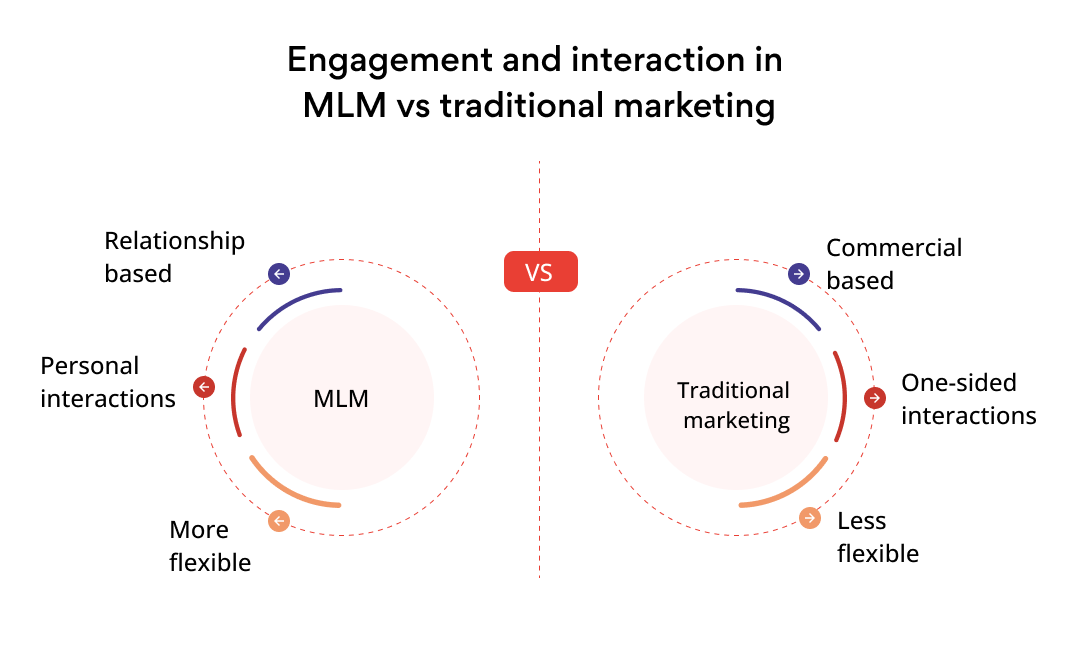
Multi-Level Marketing (MLM) really stands out because it's all about connecting with people directly. Unlike traditional marketing that just throws out ads into the world, hoping they stick, MLM goes straight to the heart of personal networks to start real conversations with real people. It's not about just pushing out messages; it's about making every interaction meaningful.
MLM isn’t just playing at the surface of relationships either; it really values them. In MLM, relationships are everything—they're the core of how things work. The feedback from these relationships makes it possible to tailor marketing messages really well, so they match exactly with what people want and need at any moment.
What's really smart about MLM is how it uses today's technology to get personal. It uses social media to hit the target audience just right, using data to fine-tune strategies as things change. This blend of tech smarts and genuine relationship-building is what makes MLM so effective.
But the real strength of MLM is its simplicity. It's flexible and cost-effective, turning from a simple marketing method into a powerful way to build lasting relationships. It creates loyalty and trust that really last. With these qualities, MLM isn't just another strategy; it's a robust way to deepen connections, increase customer loyalty, and build long-lasting trust. It is designed to efficiently meet and respond to consumer needs and demands.
On the other hand, traditional marketing methods aim to reach a vast audience but often lack the personal touch that attracts individuals into the business. The interaction in traditional marketing can feel one-sided. Companies broadcast their messages widely but not engaging customers in back-and-forth conversation. This makes it hard to tweak messages based on direct customer feedback, which is something MLM excels at thanks to its relationship-focused approach.
Traditional marketing can also be less flexible and more costly. Launching and adjusting big advertising campaigns involves a lot of time and money, and once an ad is out there, it's not easy to change it quickly based on customer reaction.
Revenue generation model
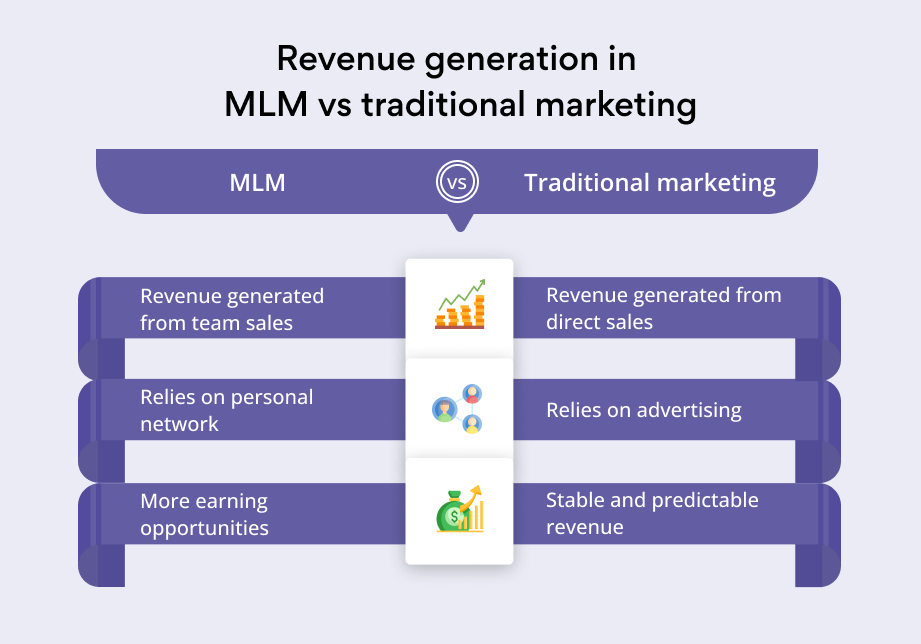
MLM works a lot different from traditional marketing model. In MLM, distributors earn money by selling products or services directly to customers. They also receive income from sales made by the people they've brought into the network. This system allows distributors to earn money from multiple levels. It is like having a team where you benefit from every sale, layer after layer. The more people they recruit, the more potential earnings they can make, especially for those at the top who have built large networks. Direct selling companies like Amway and Herbalife have shown how profitable this can be for those with an extensive downline network.
By 2030, the global MLM market is expected to reach $329 billion, with a CAGR of about 6.5% between 2023 and 2030.
Source: Zion Market Research
Traditional marketing focuses on direct sales. Companies sell their products or services straight to the consumer without a multi-level commission structure used in MLM. The main game is to cast a wide network across various advertising platforms to increase sales volume. Traditional marketing may not provide opportunities for huge earnings like MLM. But it can provide more stable and predictable revenue option.
MLM attracts people with the promise of passive income through downline activities. It can yield substantial earnings for those who manage to build large networks. MLM demands extraordinary recruitment and sales skills and also bears the risks associated with pyramid schemes.
Speed and agility
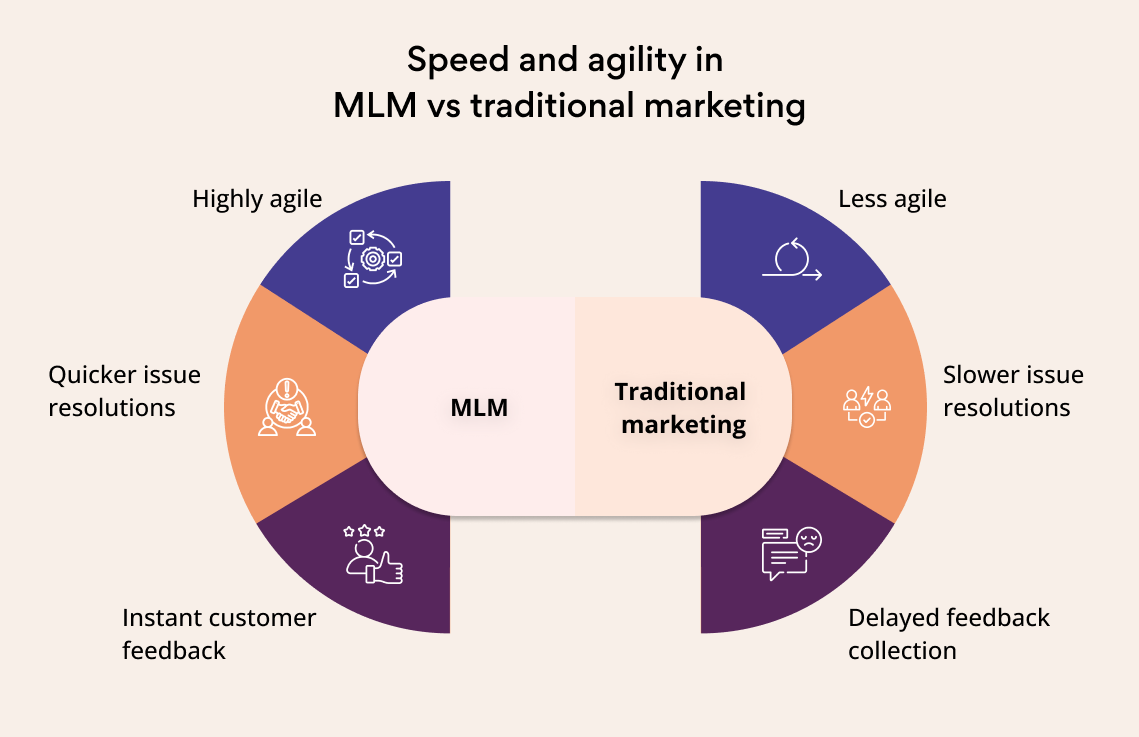
When we stack the speed and agility of MLM against traditional marketing, it is clear that each has its own set of perks. That again depends on the situation and what you are aiming to accomplish.
MLM is highly agile and ready to adapt on the fly due to its reliance on personal networks and direct selling. This setup lets MLM businesses turn their strategies in a flash and respond to consumer needs and market trends without the red tape that often slows down bigger and more traditional marketing frameworks. With digital tools and social media in their arsenal, MLM distributors can instantly connect with and adjust to their audience. They can test and tweak their marketing tactics to make quick improvements.
Traditional marketing uses methods like print ads, broadcast spots and email campaigns. These strategies generally take more time to set up and are not as easy to change once they roll out. However, the integration of digital strategies is starting to shake things up a bit, giving traditional marketing a nudge towards more agility. Digital tools help marketers collect data swiftly and tweak campaigns more flexibly, yet the very nature of traditional channels often means they can't quite keep up with the real-time interaction and adjustment speeds that digital and MLM strategies excel at.
MLM and traditional marketing have the advantages of adopting agile marketing practices. This approach is all about staying nimble, responding quickly to market shifts, updating strategies frequently and keeping the feedback loops going strong. It is especially effective in today's market, where consumer tastes and behaviors can shift in the blink of an eye. Agile marketing helps teams stay on their toes and make quicker adjustments based on real-time insights. This can really boost the effectiveness of both digital and traditional campaigns.
Cost efficiency and ROI
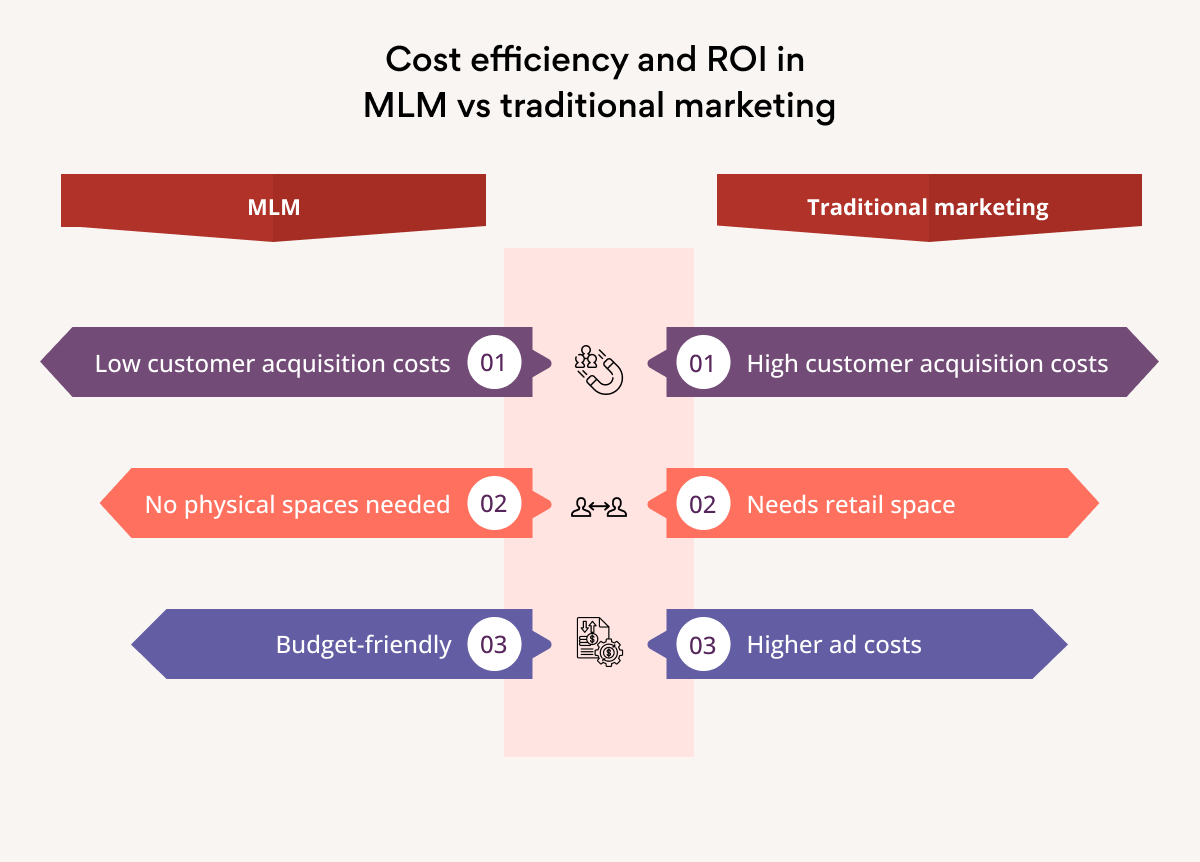
MLM is often seen as the more budget-friendly option compared to traditional marketing because it leans heavily on a network of individual distributors. These folks use their personal connections to sell products. Network marketing companies can skip some hefty expenses like maintaining physical retail spaces and investing on large advertising campaigns. Plus, MLM distributors take on a good chunk of the marketing efforts themselves, which further eases the financial load on the company.
Another big win for MLM is its use of digital marketing, which is generally a major part of its strategy. MLM digital marketing often brings a higher return on investment compared to the traditional method of advertising. Digital marketing can target specific demographics precisely and track the success of campaigns in real-time. This detailed tracking allows rapid adjustments which in turn ensure that the campaigns are effective. It reduces the chances of blowing cash on ineffective strategies. Also, scaling digital campaigns is relatively straightforward, which means you can extend your reach without proportionally increasing your spending. Most MLM companies have MLM platforms integrated with digital marketing, ecommerce, and network building tools that ensure consistent success.
Traditional marketing incurs more costs on advertisements but do not guarantee a return that matches the investment. These methods are great for spreading the word about a brand but they lack the efficiency of digital marketing. This makes it tough to track direct sales resulting from specific campaigns.
More businesses are incorporating digital strategies into their MLM business to utilize the cost effectiveness of the model and boost their ROI. Traditional marketing still is important especially for enhancing brand visibility and reach. However, integrating digital methods is also crucial to maximize both effectiveness and efficiency of brands in the market.
Startup costs and risk factors
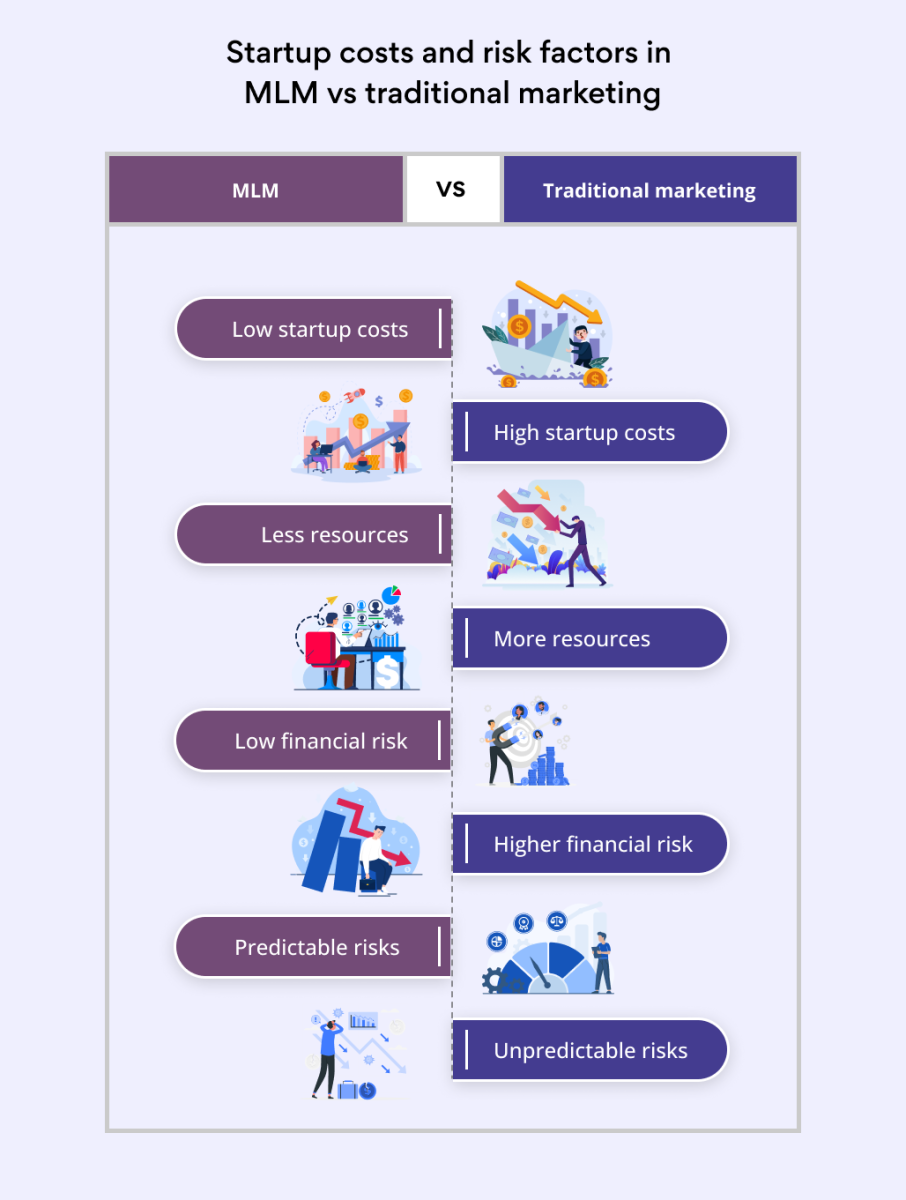
MLM is often celebrated for its low startup costs, a feature that tends to draw folks looking for business opportunities without the burden of a hefty initial investment. Typically, starting up in MLM might just require you to buy a starter kit or a bit of initial product inventory. This low barrier to entry is frequently touted as one of the big pluses of MLM.
MLM generally present a lower financial risk mainly due to these minimal startup expenses. Yet, the participant’s success hinges heavily on their knack for recruiting new members and pushing products. If the market becomes oversaturated or if they fail to grow their network, it creates a risk factor for distributors to continue in the business.
Traditional businesses demands huge initial investments. If you are setting up a traditional shop, you need to consider factors like renting a physical space, securing licenses, stocking up on inventory and other essential expenses. Not to mention, sinking a good chunk of change into advertising and customer base development, all of which introduce a higher financial risk and a tougher barrier for entry.
While traditional businesses carry the weight of larger initial investments, they also afford you complete control over business operations and a shot at stable, long-term income. The risks are more about predictable market dynamics like competition, customer demand and managing your operations. Traditional businesses offer a clearer road to growth and expansion that does not hinge on recruitment efforts, a factor some might find more stable and fulfilling.
Consumer interaction and brand representation

MLM puts the spotlight on personal relationships and direct interactions. Distributors get down to business with consumers one-on-one through social media with personalized presentations and engaging network building activities. This hands-on method can pump up the level of personal engagement and deliver customer service that fits each individual needs. In MLM, how well the brand is represented can swing widely, depending heavily on each distributor's skills and commitment. Since distributors fly solo in how they operate, there’s a risk that the brand message might get a bit muddled if it’s not kept on a tight leash. This could throw a wrench in how the market views the brand, especially if distributors stray from the company's playbook.
MLM also rolls out extensive training and support for its distributors aiming to polish their consumer interactions and brand representation skills. This support network, coming from both the company and higher-ups in the network, often ramps up the distributors' sales savvy and customer interaction chops.
Discover how we build resilient businesses with advanced MLM functionalities
Traditional marketing tends to lean on mass media like TV, radio and print ads, which typically just send the message out without a way for consumers to hit back immediately. The convo here is mostly one-way, with the audience on the receiving end of the spiel, lacking a direct line to chatter back right then and there. What traditional marketing has going for it, though, is tighter control over the brand message since it’s all managed centrally by the marketing squad or through professional agencies. This setup helps keep the brand’s voice consistent across all fronts and ensures that public communications stay true to the core values of the brand.
Team members in traditional marketing generally undergo structured training and work within a coordinated framework, which helps maintain a consistent tone and quality across different marketing drives.
Final thoughts
MLM and traditional business models offer unique sets of challenges and rewards. Traditional marketing casts a wide net to build brand awareness on a grand scale. MLM focuses on building deep, personal connections that brings warm interactions. Aspiring business owners should weigh their personal aspirations, finances and how much risk they are comfortable taking when picking a path. It is crucial to get a clear-eyed view of both the potential upsides and the drawbacks of each model before jumping in.
For those valuing flexibility, cost-effectiveness, and personal engagement, MLM provides a powerful alternative to the broad strokes of traditional marketing.
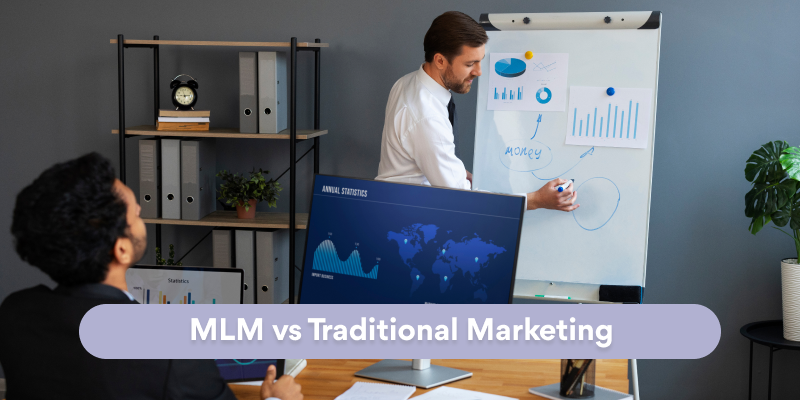





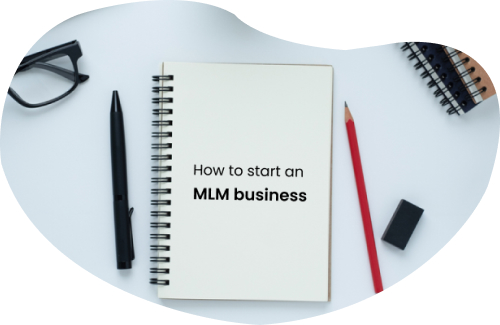

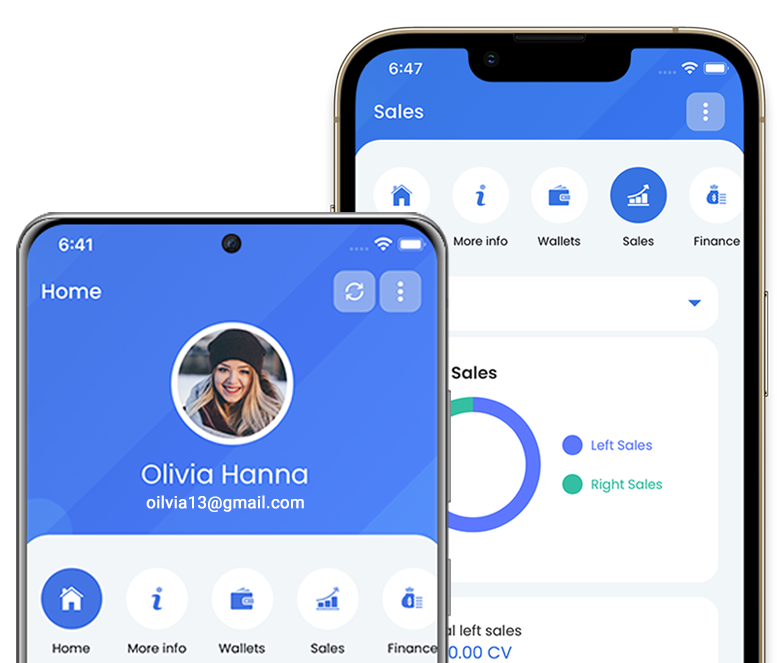
Leave your comment
Fill up and remark your valuable comment.